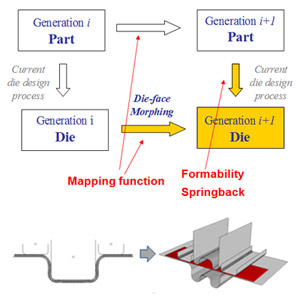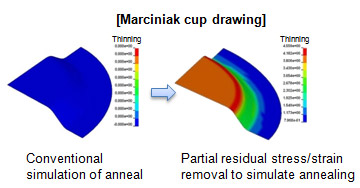Research in this area will focus on fundamental investigations on formability of various new materials, as well as the application of those materials in automotive manufacturing. Analytic, computational and experimental studies will be undertaken to advance the state of knowledge and forming capability (stamping, hydroforming, hemming, etc.) related to the use of aluminum, high strength steels and other advanced materials.
Current Project 1: Intelligent Die-Face Design using Morphing Technology
Motivation
- Automotive manufactures are facing challenges to reduce the lead time for product development to meet rapid changing market demands.
- In vehicle development, conventional Die-Face Engineering (DFE) requires lots of tryouts before a new die can be used in mass production.
- Similarities of parts commonly exist among product generations or in the same product family, which provides the possibility to make use of the existing tooling/die design for new part production.
- Morphing allows the possibility for the knowledge and experience learnt from the die-face design of one product (Generation i) to be ‘mapped/morphed’ onto that for a new but ‘similar’ product (Generation i+1).
Objectives
- Develop methodologies to expedite DFE process by integrating the information of new part (Gen i+1), existing part and die (Gen i) for new die design (Gen i+1)
Technical Personnel
Thomas B. Stoughton
Technical Fellow
S. Jack Hu, Ph.D.
Professor
Liang Zhou
Ph. D. Candidate
Current Project 2: Characterization and Optimization of Preform Anneal Forming of Aluminum Alloys
Motivation
- Aluminum alloys are increasing used in autobody manufacturing to reduce vehicle weight.
- Forming of aluminum alloys is challenging due to their lower formability compared to conventional steels.
- Preform anneal forming is promising in improving the formability of aluminum alloys, but more process understandings are needed.
- Transition between anneal and forming requires longer cycle time. An optimal in-line annealing using built-in heaters is considered to improve process efficiency.
Objectives
- To understand the material mechanical behavior in the two-stage forming with anneal
- To develop optimal localized annealing methods with numerical modeling and optimization
Deliverables
- Systematic investigation and understanding of material behaviors during preform anneal forming
- Formability of materials in preform anneal forming
- New methods of optimal localized annealing to improve the efficiency and throughput of this process

Technical Personnel
Paul E. Krajewski, Ph. D.
Laboratory Group Manager, Technical Fellow
Theresa M. Lee
Materials and Processes Lab
S. Jack Hu, Ph.D.
Professor
Jingjing Li
Ph. D. Candidate
